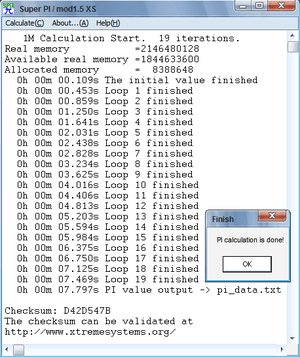Super PI
Super PI is a computer program that calculates pi to a specified number of digits after the decimal point—up to a maximum of 32 million. It uses Gauss–Legendre algorithm and is a Windows port of the program used by Yasumasa Kanada in 1995 to compute pi to 232 digits.
| Operating system | Windows |
|---|---|
| Type | Benchmark |

Significance
Super PI is popular in the overclocking community, both as a benchmark to test the performance of these systems[1][2] and as a stress test to check that they are still functioning correctly.[3]
Credibility concerns
The competitive nature of achieving the best Super PI calculation times led to fraudulent Super PI results, reporting calculation times faster than normal. Attempts to counter the fraudulent results resulted in a modified version of Super PI, with a checksum to validate the results. However, other methods exist of producing inaccurate or fake time results, raising questions about the program's future as an overclocking benchmark.
Super PI utilizes x87 floating point instructions which are supported on all x86 and x86-64 processors, current versions which also support the lower precision Streaming SIMD Extensions vector instructions.
The future
Super PI is single threaded, so its relevance as a measure of performance in the current era of multi-core processors is diminishing quickly. Therefore, wPrime has been developed to support multiple threaded calculations to be run at the same time so one can test stability on multi-core machines. Other multithreaded programs include: Hyper PI, IntelBurnTest, Prime95, Montecarlo superPI, OCCT or y-cruncher. Last but not least, while SuperPi is unable to calculate more than 32 million digits, and Alexander J. Yee & Shigeru Kondo were able to set a record of 10 Trillion 50 Digits of Pi using y-cruncher under a 2 x Intel Xeon X5680 @ 3.33 GHz - (12 physical cores, 24 hyperthreaded) computer on October 16, 2011[4] Super PI is much slower than these other programs, and utilizes inferior algorithms to them.
References
- Maekinen, Sami (2006), CPU & GPU Overclocking Guide (PDF), ATI Technologies Inc.
- Martinović, G.; Balen, J.; Rimac-Drlje, S. (2010), "Impact of the host operating systems on virtual machine performance", 2010 Proceedings of the 33rd International Convention MIPRO, IEEE, pp. 613–618.
- Sanchez, Ernesto; Squillero, Giovanni; Tonda, Alberto (2011), "Evolutionary Failing-test Generation for Modern Microprocessors" (PDF), Proceedings of the 13th Annual Conference Companion on Genetic and Evolutionary Computation (GECCO '11), New York, NY, USA: ACM, pp. 225–226, doi:10.1145/2001858.2001985, ISBN 978-1-4503-0690-4.
- Round 2... 10 Trillion Digits of Pi, numberworld.org
External links
- Kanada Laboratory home page, formerly with link to ftp site with version of the program for different operating systems.
- "Single-threaded Computer Benchmark | SuperPI". www.superpi.net. Retrieved 2019-12-22. wPrime Systems version.